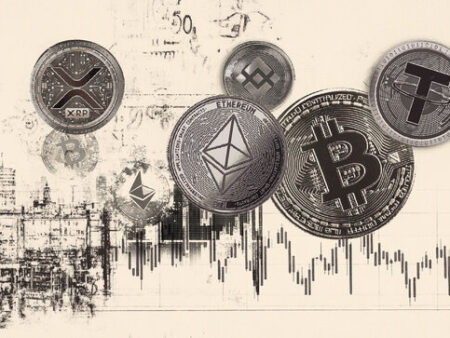Bitcoin Stabilizes Around $106,000 Amid Profit-Taking and Institutional Demand
Bitcoin (BTC) is finding its footing around the $106,000 mark on Friday, following a three-day correction that has resulted in a near 3% dip this week. This price adjustment has been further influenced by profit-taking activities among BTC holders, which have reached a three-month high.
Despite the short-term selling pressure, institutional demand remains strong. Companies like Strategy (formerly MicroStrategy) and GameStop have added Bitcoin to their balance sheets. Spot Bitcoin exchange-traded funds (ETFs) continue to see inflows, highlighting ongoing confidence in the largest cryptocurrency by market capitalization and its long-term potential.
Profit-Taking Increases Downward Pressure
Data from Santiment’s Network Realized Profit/Loss (NPL) metric indicates that some BTC holders are cashing in on their gains.
The NPL experienced a significant spike on Tuesday, marking the highest level of profit-taking since February 5th. A smaller spike was also observed later on Friday. These spikes suggest that holders are, on average, selling their holdings at a significant profit, thereby increasing selling pressure.
Glassnode’s weekly report highlights that investor profitability and spending behavior have notably increased, though current levels remain below the extremes seen before previous bull market peaks.
The Volatility-Adjusted Realized Profit/Loss metric measures realized profit and loss in BTC terms, normalizing it relative to Bitcoin’s increasing market capitalization across cycles. It is further refined by adjusting for the 7-day realized volatility to account for Bitcoin’s diminishing returns and slower growth rate as the asset matures.
As the price of BTC recovered through its previous all-time high, a notable increase in profit-taking was recorded, with only 14.4% of days registering higher values. This suggests that profit-taking has increased but has not yet reached extreme levels.
Corporate and Institutional Demand Remains Robust
Corporate and institutional interest in Bitcoin has continued to strengthen despite its slight correction this week.
The week began with Strategy adding 4,020 BTC for $427.1 million on Monday, bringing its total BTC holdings to 580,250 BTC. On Wednesday, U.S. video game retailer GameStop made its first Bitcoin purchase, acquiring 4,710 BTC. This acquisition follows GameStop’s $1.3 billion convertible note offering in March, as part of its plan to include Bitcoin as a treasury asset. On Thursday, Japanese investment firm Metaplanet announced it has issued $21 million in Ordinary Bonds to purchase more BTC; the firm currently holds 7,800 BTC in its treasury.
The interest from corporate entities in Bitcoin indicates a growing acceptance of BTC as a strategic asset, increasing its legitimacy and potentially driving long-term adoption.
Looking at institutional demand, data from SoSoValue shows that U.S. spot Bitcoin ETFs recorded a total inflow of $458.82 million through Thursday, continuing their seven-week streak of weekly inflows since mid-April. Furthermore, the monthly ETF inflow reached $5.85 billion in May, the highest level since December and surpassing levels seen after President Donald Trump’s inauguration in January. If this institutional inflow continues or intensifies, the price of BTC could recover and head towards its all-time high of $111,980.
Bitcoin Fails to Rally Despite Easing Tariff Fears
Bitcoin started the week on a positive note as President Donald Trump announced on Monday that he agreed to extend the implementation date of the 50% tariff on EU goods from June 1st to July 9th. This news followed last Friday’s announcement of imposing 50% tariffs on imports from the European Union, as Trump said negotiations in Brussels were not progressing. The Friday announcement triggered risk-off sentiment in the market, with Bitcoin falling 3.9% that day.
This delay in the EU tariff slightly boosted investor sentiment and triggered a mild increase in risk appetite. The broader market reacted positively to this news, and Bitcoin recovered slightly, closing above $109,000 that day.
This week, the U.S. took an unexpected move regarding its tariffs. The U.S. Court of International Trade announced on Wednesday that it had blocked Trump’s reciprocal tariffs that were announced on so-called “Liberation Day.” The court ruled that the president exceeded his authority by imposing broad tariffs on imports from U.S. trading partners.
The three-judge panel issued a permanent restraining order on the broad tariff orders issued by Trump since January and ordered the issuance of new orders reflecting the permanent restraint within ten days. The Trump administration has appealed the decision.
Overall, markets reacted positively to this news, with the U.S. dollar (USD) strengthening and global stocks rising due to optimism surrounding reduced trade frictions. However, risk assets like Bitcoin failed to rally and fell slightly on Wednesday, closing below $105,600 the following day after reaching a new all-time high of $111,980 the previous week.
Macroeconomic Developments
U.S. macroeconomic data releases this week failed to support risk sentiment. The minutes from the Federal Reserve’s (Fed) May monetary policy meeting, released on Wednesday, showed that officials perceived elevated uncertainty about the economic outlook.
“Participants noted that they could face difficult trade-offs if inflation proved more persistent while the outlook for growth and employment weakened,” the release indicated.
Risk sentiment continued to fade on Thursday as U.S. pending home sales fell to a one-year low of -6.3%, while initial jobless claims rose more than expected to 240K compared to the previous week. Additionally, first-quarter Gross Domestic Product (GDP) contracted by 0.2% on an annualized basis.
The U.S. Personal Consumption Expenditures (PCE) price index for April will be released on Friday and will be a key reading for investors. As the Fed’s preferred measure of inflation, PCE price growth has a direct link to when and how much the central bank will move interest rates.
Bitcoin’s Technical Outlook Shows Fading Bullish Momentum
Bitcoin’s price fell and closed below its daily level of $106,406 on Thursday, following its continued correction over the previous two days. As of Friday, it remains and trades below $106,000.
If BTC continues its correction, it could extend the fall to revisit the psychologically important level of $100,000.
The Relative Strength Index (RSI) marks 54 on the daily chart, pointing downwards towards its neutral level of 50, indicating fading bullish momentum. Additionally, the Moving Average Convergence/Divergence (MACD) indicator also showed a bearish crossover. It also shows increasing red histogram bars below its neutral level, indicating a correction ahead.
However, if BTC recovers and closes above its all-time high, it could extend the rally towards the key psychological level of $120,000.
Bitcoin, Altcoins, and Stablecoins: FAQs
What is Bitcoin?
Bitcoin is the largest cryptocurrency by market capitalization, a virtual currency designed to serve as money. This form of payment cannot be controlled by any single person, group, or entity, eliminating the need for third-party involvement during financial transactions.
What are Altcoins?
Altcoins are any cryptocurrencies other than Bitcoin. Some consider Ethereum not to be an altcoin because it is from these two cryptocurrencies that forking occurs. If this is true, then Litecoin is the first altcoin, forked from the Bitcoin protocol and, therefore, an “improved” version of it.
What are Stablecoins?
Stablecoins are cryptocurrencies designed to have a stable price, with their value backed by a reserve of the asset it represents. To achieve this, the value of any stablecoin is linked to a commodity or financial instrument, such as the U.S. Dollar (USD), and its supply is regulated by an algorithm or demand. The main goal of stablecoins is to provide an on-ramp and off-ramp for investors who wish to trade and invest in cryptocurrencies. Stablecoins also allow investors to store value, as cryptocurrencies, in general, are subject to volatility.
What is Bitcoin Dominance?
Bitcoin dominance is the ratio between Bitcoin’s market capitalization and the total market capitalization of all cryptocurrencies combined. It provides a clear picture of the interest in Bitcoin among investors. High BTC dominance often occurs before and during a bullish movement, in which investors turn to investing in relatively stable and high market capitalization cryptocurrencies like Bitcoin. A drop in BTC dominance usually means that investors are moving their capital and/or profits to altcoins in search of higher returns, which often triggers an explosion of gains in altcoins.
Stay ahead of the curve in the fast-paced crypto world – explore the latest updates and trends at Cryptonewsfeeds.com.










